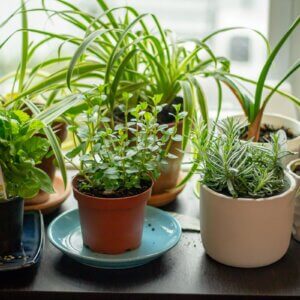Table of Contents
Hair is fine to compost as long as it is not treated with synthetic chemicals or infested with disease or parasites. Healthy hair’s nitrogen content supports the growth of composting microorganisms. Overapplication of hair, however, can cause issues in your compost pile.
In addition to traditional hot and cold composting techniques, hair is suitable for Bokashi, and vermicompost methods. If you cannot compost, consider sending your hair clippings to recycling facilities or charitable organizations.
Have an in-depth look at the process of composting hair into nutrient-rich compost below.
How to Compost Hair
You can incorporate both animal and human hair in your compost pile. They are rich in nitrogen, and by maintaining optimal pile conditions and closely managing your compost, you can efficiently convert hair waste into nutrient-rich compost.
Preparing Hair for Composting
Untreated hair requires minimal preparation before composting. As a general composting rule, small pieces of organic waste decompose faster. Chop untreated hair and sprinkle it as you layer your compost ingredients.
Ensure that your hair clippings are free from nonbiodegradable components like metal hair clips or rubber bands.
Avoid dumping hair waste all at once. Doing so can trigger clumping issues within your compost bin or pile.
There isn’t enough research on the negative effects of hair products — such as synthetic creams, dyes, oils, and sprays — on the composting process, soil health, and plant growth. It’s safe to assume they have synthetic chemicals that can interfere with your composting process. So best to omit treated hair from the pile or bin, especially if you’re aiming for an entirely organic compost.
Synthetic hair extensions or wigs are not suitable for home composting.
Optimal Composting Conditions for Hair
When layering your compost materials, stick to the ideal ratio of 25 to 30 parts of carbon materials to every 1 part of nitrogen materials. Aside from human and pet hair, used coffee grounds, and other common kitchen waste, like fruit trimmings and vegetable scraps, are excellent nitrogen green ingredients, boosting the pile’s microbial development and growth.
Carbon from cardboard, egg carton, grass clippings, newspaper, and untreated sawdust or wood chips serves as an energy source for these composting microorganisms. A good balance of such materials will increase the efficiency of your compost bin or pile in breaking down organic materials.
Moisture is crucial in the decomposition process. Your compost pile should be wet, but not soggy. Excess fluids — together with inadequate oxygen — are primary conditions for anaerobic decomposition. Under these conditions, your compost pile will emit unpleasant odors.
To minimize this problem, incorporate more carbon ingredients. For instance, dried grass clippings or shredded newspaper will absorb the excess fluids.
Hot compost with hair waste should have a temperature range of 90 to 140 degrees Fahrenheit. Turning your compost pile regularly will tremendously improve its air circulation.
Again, do not overload your compost pile with large amounts of hair to avoid clumping. Bundles of hair can clog your compost and hinder proper air flow.
Sustain these conditions to successfully convert hair into compost.
How Long Does Hair Take to Compost?
In a well-managed compost pile, hair quickly decomposes (in about a month). Factors that affect decomposition include oxygen, heat, and moisture in your compost pile.
How Hair Affects the Composting Process
Inclusion of hair in moderate amounts is beneficial to the composting process. Too much of it can negatively inhibit the proper decomposition of your compostable materials. Overloading your compost pile with heaps of hair will impede proper decomposition and hinder adequate air circulation. Bundles of hair can clog the pile.
Impact on Decomposition
Due to the thin structure, hair decomposes easily under optimal pile conditions. Chopping it in small pieces will further accelerate your composting process.
When using hair waste for composting, apply in moderation.
Microbial Activity
Hair is rich in nitrogen — an element crucial to the decomposition process of organic wastes. Nitrogen boosts microbial development and growth within your compost heap. Keeping a healthy community of microorganisms will increase the pile’s efficiency in transforming organic matter to finished compost.
Our pro-tip: Offset hair’s nitrogen content with carbon-rich materials such as dead leaves and shredded cardboard.
Temperature and Moisture
Hair has no direct effect on the pile’s temperature. However, continuous microbial action within your compost bin or pile will raise its internal temperature. In hot piles especially, this intense heat “cooks” organic matter, breaking it down significantly quicker.
Also, hair does not contribute moisture, unless you use wet hair for composting. Dry hair should be paired with nitrogen-rich green materials.
Be cautious when incorporating drenched or washed hair. The water can throw off the pile’s moisture level. If you notice excess liquids leaking out of your compost, add more carbon materials.
Potential Issues With Composting Hair
Apart from potential clumping issues, hair does not usually cause trouble when composting.
Will Composting Hair Attract Pests?
Hair does not typically attract problematic pests. You can safely include it in your compost pile without worry. Always adhere to the optimum compost pile conditions to efficiently convert hair waste to nutrient-rich compost.
Will Composting Hair Cause Odors?
When processed in a well-managed pile, hair does not emit foul odors. Be cautious with anaerobic decomposition, however. Lack of oxygen and excess fluids triggers such conditions, primarily linked to a smelly compost. Adding too much hair at once can make your compost heap prone to this issue.
To prevent anaerobic decomposition, turn the pile regularly and keep its moisture balanced.
Methods for Composting Hair
Several composting techniques are suitable in handling animal and human hair waste.
Hot Composting
You can definitely use hair for hot composting.
This method involves sustained microbial activity that heats up the compost pile. Under high temperatures, organic material breaks down more quickly, but hot composting systems are not for everyone. First-time composters may find it difficult to maintain.
For best results, regularly check the pile’s temperature and aerate it by turning. These steps will ensure high-quality composting of hair and other organic matter.
Start by sprinkling minimal amounts of chopped or cut hair between layers of brown, and green materials. Aim for the ideal temperature range of 90 to 140 degrees Fahrenheit.
Cold Composting
Cold composting is the complete opposite of hot composting. This method relies on nature and its innate power to break down organic matter such as hair.
Naturally occurring bacteria, microbes, and other external elements like air, sunlight, and water, are the primary agents of decomposition in cold piles. The only caveat with a cold system is that it takes longer to produce compost.
Chopping or cutting your hair waste will help accelerate the decomposition in cold compost piles. Apply in moderation to prevent problems within the pile. Being a great source of nitrogen, hair should be combined with carbon-rich brown ingredients.
Vermicomposting
Healthy hair free from chemicals or diseases can be fed to your worm farm.
In vermicomposting, worms consume organic material, and break it down through digestion, resulting in nutritious worm castings. Due to its keratin content, hair provides protein to your worm farm’s diet. Simply introduce small amounts of hair and offer other food sources that will keep your worm farm healthy.
Safeguard your worm farm from disease- and pest-infested hair from animals and humans. Omit these types of hair as they can harm your worm farm.
Chemically treated hair should be excluded from your worm bin also. Worms are highly sensitive and chemical traces from synthetic creams, dyes, oils, and sprays can either harm or irritate them.
Bokashi Composting
For composters with limited garden or outdoor space, consider Bokashi composting your hair clippings and fallen pet fur.
Unlike other methods, Bokashi encourages anaerobic decomposition, sealing the organic matter in a specialized Bokashi bucket. Fermentation of your materials will depend greatly on the activity of fermenting microbes found in the Bokashi bran inoculant. These microbes thrive on proteins found in hair and food scraps. Bokashi is known to process primarily food waste, including unconventional materials like dairy and meat.
Correct preparation and minimal quantity of hair will lead to a successful Bokashi compost.
Alternatives to Composting Hair
If you cannot compost hair at home, you can send it to sustainable facilities where they are transformed for greater use.
Industrial Composting of Hair
Large-scale commercial composting facilities accept animal and human waste like hair. The finished compost from these facilities is usually used for agriculture and industrial purposes
States have varying guidelines on waste management. Some facilities offer curbside pick-up services and drop-off options.
Reach out to your nearest compost facility to learn how they accept hair waste.
Recycling Hair
Significant amounts of hair waste can be sent to recycling centers.
For instance, Terracycle® offers SalonCycle to barbershops and salons. This commercial service collects various hair salon waste products and materials such as aerosol cans, gloves, hair clippings, and synthetic hair trimmings. For more information, head on SalonCycle’s product page.
Matter of Trust accepts fleece, fur, and hair waste for their Clean Wave program. These materials are repurposed into oil absorbers used in sea spills and other oil contamination incidents.
If you have hair that’s at least 10 inches in length, you can donate it to Locks of Love. This charitable organization produces recycled hairpieces for children with hair problems.
Upcycling Hair
You can directly apply thin layers of healthy hair on your garden soil as mulch.
According to researchers, hair’s nitrogen content boosts plant growth, but hair decomposes and releases essential nutrients slowly when left alone in the open. Pair your hair waste with other fast-acting fertilizers as sources of nourishment for your garden.
Disposal Options for Hair
Dispose of your hair waste in an appropriate garbage bin when all options are unavailable.
What Hair Shouldn’t Be Composted?
Made of synthetic fibers, loose hair from inorganic wigs or extensions should never go to your compost. These strands will not decompose like the rest of the organic wastes and contaminate your compost with toxic chemicals.
Steer clear of hair heavily treated with synthetic bleach, creams, dyes, oils, and sprays. These hair products may impede proper decomposition and harm composting microorganisms.
Be cautious with disease- and pest-infested hair. Pathogens and parasites can survive the composting process, especially if you’re unable to attain optimal pile temperatures. When composting, ensure cat and dog hair come from healthy pets.
Safety and Precautions When Composting Hair
Avoid stuffing your compost bin or pile with too much hair as it can cause clumping. Ensure optimal pile conditions by sticking to the best pile management practices.
After composting, remember to wash your hands thoroughly with soap and running water.
FAQ
Can I put hair in my garden soil?
Hair can be applied as mulch on your garden soil. It aids with plant growth due to its nitrogen content. However, hair takes a longer time to decompose and won’t release nitrogen instantly.
Can I add hair to my worm composting bin?
Small amounts of hair that is free from chemicals, disease, and pests are fine to vermicompost. Hair clippings provide protein essential for your worm farm’s health.
How much hair can I add to my compost pile?
Inclusion of hair should be done in moderation. Too much hair can cause clumping within your compost pile, slowing down decomposition and impede air circulation.









































Leave a Reply